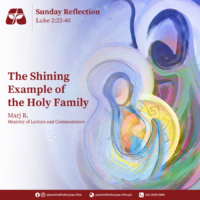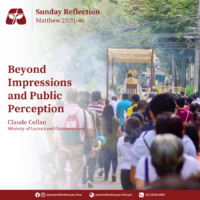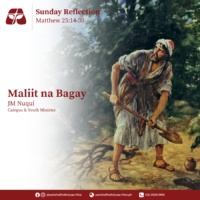A reflection on “Humanae Vitae,” an encyclical letter by Blessed Pope Paul VI, by Marie Gabrielle M. De Luna
Last July 25 marked the 50th year anniversary of Humanae Vitae. Humanae Vitae (“Of Human Life”) is an encyclical letter issued by Blessed Pope Paul VI on July 25, 1968 as a response to the sexual revolution in the 1960s. A particular innovation introduced during that time, the oral contraceptive, known colloquially as “The Pill”, raised moral questions that greatly troubled men and women of faith. The letter was a declaration of the stance of the Church on the matter, condemning “unlawful birth control methods” such as abortion, sterilization, and “any action which either before, at the moment of, or after sexual intercourse, is specifically intended to prevent procreation…” (HV, 14) You may not have heard of the letter, but you can hear Pope Paul VI’s voice through the Church in our country as it continues to oppose artificial birth control methods.
The pope opens the letter with the grave statement, “The transmission of human life is a most serious role in which married people collaborate freely and responsibly with God the Creator.”
I, as an unmarried young adult, couldn’t help but think at first that this letter did not have much to do with me. But, upon reading it, I realized that it had a much more universal message as Bl. Paul VI touched upon a topic that concerns all of us: human sexuality.
Growing up, sex was such a taboo topic that I honestly thought it was something wrong and gross. Imagine my surprise when I first read of it and heard of it described as something “beautiful” and “a gift from God” in Catholic books and by Catholic speakers during my teenage years. This led me to learn more about the Catholic perspective on sexuality. I was left in awe as Church teachings integrated sexuality and the dignity of man.
Man and woman were created very different from the other but both were made in the image of God and with equal dignity (CCC 2335). They can be united in the most intimate way possible through the sexual act which is a “sign and pledge of spiritual communion” (CCC 2360). This act, when used according to God’s design, is an expression of love because, as I understood it, anything short of love is an injustice to both man and woman. Moreover, this love according to Pope Paul VI, is “not confined wholly to the loving interchange of husband and wife; it also contrives to go beyond this to bring new life into being.” (HV 9)
In no other human circumstance I know can the famous quote “Where there is love, there is life” attributed to Mahatma Gandhi be thought of in a literal sense than in marriage. A man and a woman’s selfless giving of self to each other can bear new life, a child, and create that one small community we call a family. On this human trinity designed by God through “laws written into the actual nature of man and woman” (HV 12) is stamped an image of the Trinity: God Himself, who is one and a community of life-giving Love. It is one of the main reasons why the Church opposes the use of contraception as it deliberately removes one meaning and purpose of sex, that is, the ability to bear life. The connection between the unitive and procreative powers in the sexual act is something that man cannot willfully break because it is against the nature of man and woman, and is against the will of the Author of Life (HV 12-13).
Towards the end of the encyclical, Pope Paul VI calls for the promotion of chastity. Nowadays, being chaste is equated to being prudish (a somewhat derogatory term commonly understood as someone who is easily shocked/offended by anything related to sex). This is not the case, at all. Chastity is not a repression of sexuality. It is the ordering of sexuality; a virtue that allows us to have control over our sexual desires rather than have our desires control us. The gift of sexuality comes with a responsibility to use it in the way it was designed by God.
Pope Paul VI’s teachings in the letter proved to be unpopular. Strong opposition inside and outside the Church on one hand, and poor catechesis on the other, made Humanae Vitae one of the most rejected encyclical letters even by a lot of Catholic faithful. Until now, members of Church hierarchy and laity are divided over the issue, a division that we can see even here in our own country. Common arguments we hear for the use of contraceptives are fears of overpopulation, worsening of poverty due to lack of ability to support number of children, and the spread of sexually transmitted diseases, which are valid issues.
Now that Humanae Vitae has turned half a century old, I think a reflection on this letter as a Church, especially here in the Philippines, is long overdue. One question we must ponder deeply is, what really is the best way to address the problems that, as they say, contraceptives seek to alleviate? Those who believe Humanae Vitae to be true must also believe that there are better solutions.
There is actually an alternative to using contraception for family planning known as Natural Family Planning (NFP). It’s existence, though, is not enough if a lot of people don’t even hear about it much less understand it. There has to be a strong movement for it and people behind the movement. But, how can the Church attract people, particularly the lay faithful that comprise the Church’s majority, to strengthen this movement?
I believe we must go back to something more fundamental–the Christian understanding of human sexuality. Just as I mistakenly thought that sex was something inherently wrong in the past, I think a lot of people easily dismiss the Church’s stance on most issues due to misunderstandings. We have to find ways to learn as individuals and as a community the Catholic teachings on sexuality, not just for married couples but for the youth as well. Start with making it a goal to read Humanae Vitae this year. The letter is not that long. Form group discussions with your family and/or friends and don’t hesitate to ask our priests if you have questions.
Beyond all of these, however, we must not forget to reflect on Humanae Vitae in prayer. It is through prayer that we can discern how the Lord wants us to respond to the issues in our times and receive the grace to be both courageous and compassionate in carrying out our response.
The message of Humanae Vitae is difficult; the struggle to live chastely according to our current vocation, challenging. However, we are not left to our own devices. Abundant graces are given to us in the Eucharist as we receive the Lord, the Giver of Life himself. But, for the times that we are overcome, our loving God is waiting for us in the Sacrament of Reconciliation, ready to help us try again.
Bl. Pope Paul VI and Mary, Queen of Families, intercede for us.
CCC: Catechism of the Catholic Church (https://tinyurl.com/CatCathChurch)
HV: Humanae Vitae (Encyclical letter by Blessed Pope Paul VI: https://tinyurl.com/HVat50)
Bl. : Blessed
_______________________________
Marie Gabrielle De Luna received her Bachelor’s Degree in Physics from the National Institute of Physics, UP Diliman. She actively participates in several Parish activities through the Catechetical, Media and Campus ministries.


